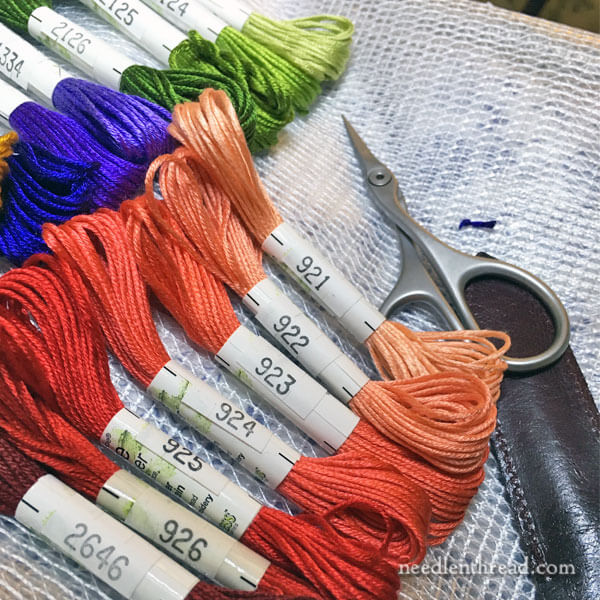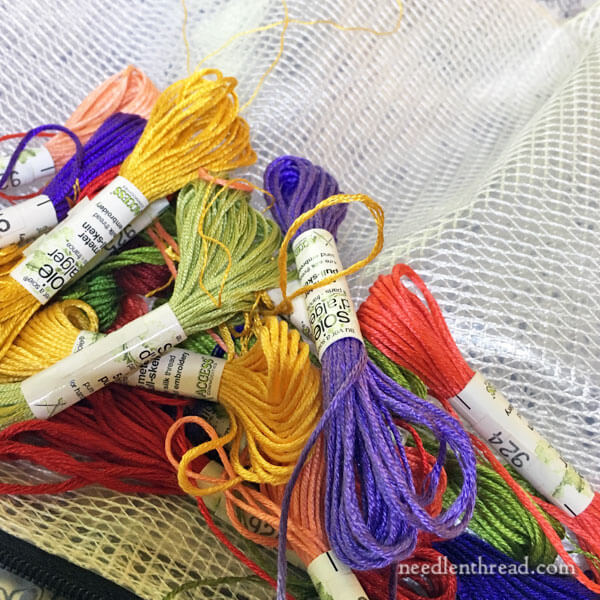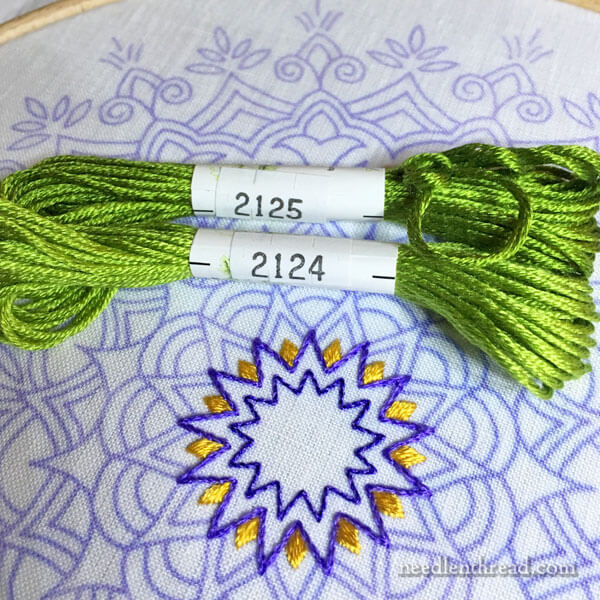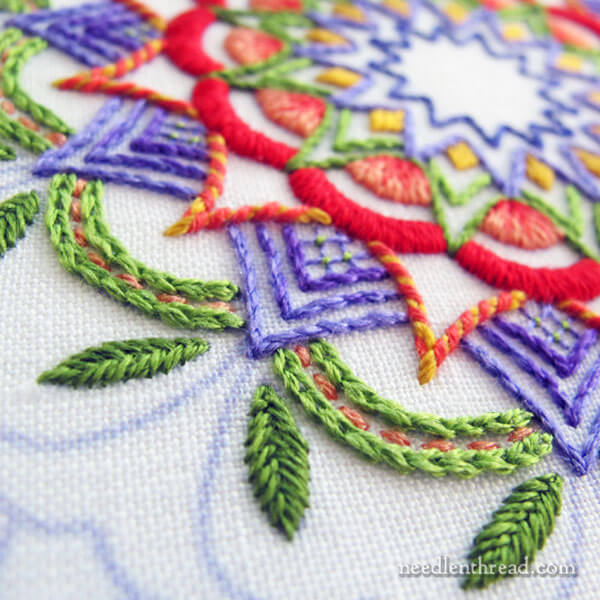It’s been a long time since I’ve embroidered a whole project in silk threads.
But the fact is, I love silk embroidery threads, and if I could, I’d embroider the entire world with silk thread!
So you can well imagine how excited I am to launch into another little (bigger) kaleidoscope project, this time worked entirely in silk. I’m in Hog Heaven – Silk Hog Heaven, that is!
I picked out a four-color, multi-shade palette to work with for this particular design. I found myself sucked into the project, dreaming about it at night and waking up extra early to get stitches in. You know how it is…
So, today I thought we could chat about these particular silk threads, because I love them so.

My favorite all-time line of silk threads comes from Au Ver a Soie, a French company whose threads are imported into the US through Access Commodities.
I love Au Ver a Soie’s threads for several reasons:
1. Their collection of Soie d’Alger is amazing. This is a stranded, spun silk that comes in some hundreds and hundreds of shades, making it perfect for all kinds of surface embroidery and counted work.
2. Besides Soie d’Alger, they have other types of silk threads – from twisted Soie Perlee (a heavier twisted filament silk), to Soie de Paris (a fine stranded filament silk) to Soie Ovale (a flat silk), to Silk Trame (which is new, and I wrote about it here), to Soie 100/3, which is perfect for tiny details and for machine work, to Soie Gobelin, also perfect for tiny details, and others – and all of them are coordinated color and number wise, which makes it easy to work across a given color scheme with different types of silk.
3. Their quality is unsurpassed in the thread market. While there are many other lines of threads – including silk threads – that I like a lot, when it comes to consistent, good quality silk embroidery thread, Au Ver a Soie can’t be beat. You won’t find slubs (lumps of thicker places) or inconsistencies in twist in their threads. They have a really high standard of quality control, and I appreciate that a lot!

The project I’m working on right now is all Soie d’Alger. This is Au Ver a Soie’s stranded spun silk.
Soie d’Alger (and any stranded, spun silk) works a lot like stranded cotton. Each thread as it comes off the skein is comprised of seven strands which can be separated from the whole bunch and used individually. Each strand is made up of two tiny plies of silk (these are not separated – they’re twisted together softly to make the strand).
One strand of Soie d’Alger works up slightly heavier than one strand of cotton floss. The silk is more softly twisted – and it’s softer in general – than cotton, so it has a different “spread” to it as you stitch, making it a little heavier on coverage.

Because it’s silk, Soie d’Alger has a beautiful, soft sheen.
While cotton’s sheen is chemically produced (through a process called mercerization), silk’s sheen is natural. It will never “un-sheen” over time. Silk, by it’s very nature, is “sheeny.” I don’t want to say it’s shiny, because “shiny” conjures up images of glare and maybe even garishness. The sheen from silk is never garish.
I guess you could call it shiny, but it’s not a fake-shiny. It’s a classy, luxurious shiny.

Soie d’Alger works well for practically any kind of common surface embroidery stitch.
Because of it’s soft spread, it makes an exceptionally beautiful satin stitch and long and short stitch. But it also makes a gorgeous chain stitch, stem stitch, fishbone stitch, backstitch, whipped stitches… really, any kind of stitch!
New to Silk Threads?
If you’re a newcomer to silk thread, Soie d’Alger is a great thread to start with. It’s structure is familiar, if you’re used to working with cotton floss.
In some ways, though, it’s slightly more fiddly to work with, compared to cotton.
Tips for Working with Silk
1. Smooth your hands. Silk tends to snag on rough hands. I like to use this olive oil and sugar scrub when I’m working with silk threads. I’ll usually give my hands a good scrub down with the stuff in the morning and evening whenever I’ve got a silk thread project going, depending on the state of my hands. And a moisturizer at night doesn’t go amiss, either.
2. Use shorter lengths of thread. When working with spun stranded silk especially, shorter lengths are ideal. I use approximately a 13 – 14″ length of thread when working with Soie d’Alger, cutting the thread the length of my forearm, from my fingers to my elbow. Anything longer can be frustrating, especially if the thread snags on anything. It’s always easier to prevent frustration than to deal with it if it comes along, so I always opt for shorter lengths of thread.
3. Wind any unused strands of silk floss back around the original skein or spool, so you can keep track of it. Don’t drop the unused lengths in with your orts while you’re working! Silk is expensive, and it’s a good idea to get the most you can out of every length and to keep track of unused strands!
Where to Find Soie d’Alger
You can find Soie d’Alger through any local needlework shop that carries products from Access Commodities. If they don’t have the thread in stock, you can often special order it.
Because I don’t have a local needlework shop, I order online.
More Information about Silk Threads
If you’d like to learn more about working with silk threads, here are some previous articles on Needle ‘n Thread that will help familiarize you with silk:
Comparison of Twisted Silk Embroidery Threads
Working with Soie de Paris (and other filament silks)







Dear Mary
A lady after my own heart I love, love Soie d’Alger silk thread and I work with silk thread most of the time lately because I’m either embroidering monograms or covering more Dorset buttons and the silk looks really nice on the buttons. I even purchased for myself the Soie d’Alger thread book so before I order I can actually see the thread colours. Also I can buy the Soie d’Alger quote easily here in the UK at SewandSo and thats another reason why I like the thread. I can’t wait to see your progress on your new project using silk thread. Thanks for sharing your news on your new project and the talk on silk threads.
Regards Anita Simmance
Thanks, Anita, I was just wondering who stocks it in UK!
You can also purchase a wide range of these silks (and others) at West End Embroidery in London. Like SewandSo, excellent service.
I’d say silk seems to glow from within, rather than reflecting light. I’ve used silk sewing thread more than silk embroidery thread, but both are lovely to work with. As long as I remember to use the oil/sugar scrub frequently and use the heavy-duty moisturizer every night.
How can something look so stunningly beautiful and so much fun at the same time?!
Thanks for the silk tips!
Mary,
I use moisturizer every night also with good effect. I also use a file on my thumb and sometimes other fingers, especially in the winter, and that works well too.
Did you transfer that pattern onto the linen?
Dear Mary,
Will you be sharing the progress of this project and possibly offer a pattern?
Thanks!
I am very excited to see this information! I have just ordered some Soie D’Alger from http://www.latelierdepenelope.com/
I am delighted by the thought of using a hand scrub because of embroidery. I’m going to put all the tips into practice.
Thanks Mary!
I have been an embroiderer for around 57 years and until about 6 years ago had never worked with silk.
A project I started then – and am still working on – was a mixture of cotton floss, crewel yarn and silk floss. It is a reproduction of a late 18th century/early 19th century chair cushion (which it will not be made into).
I work on the piece at reenactments when I am demonstrating embroidery so the piece and the threads are not treated as well as what I work on at home. The fabric is folded and shoved in a small round box. The threads are on a thread holder shoved in a plastic zip lock bag with the instructions. The piece is sometimes dropped quickly into our wooden box which doubles as a seat. I have to take the threads I may be using off of the holder in advance and wind them onto reproduction wooden bobbins and then before the next event – unwind them and put them back onto the holder (and take out and wind the threads to be used next time).
The above plus the fact that my right thumb can get dry and hard around the edge of the nail sometimes had me quite concerned about the silk floss. I was amazed at the lack of problems with it and that it did not snag, etc. on my thumb if it gets dry. After all, before I get to sit and stitch, I am helping set up tables, tents, pots, etc. for the camp.
I tell those who are watching me and show them the 3 different types of material I am stitching with, both how they look on the piece and on the bobbins.
I love the colours and sheen of these threads, but am always cautious about using them in a project because my understanding is that I could not (or should not) wash a silk-embroidered project- so I tend to think of them only for pieces that might be framed under glass. I was especially interested to read Anita’s comment about using silks for Dorset buttons (something I have on a wish list to try one day). Could silk-embroidered buttons actually be applied to clothing and washed (say on a “delicates” cycle in a front-loader machine), or would you only use them on dry-clean-only clothing, or very delicate, seldom washed items? Would be interested to hear comments and experience about care of silk-embroidered items.
Hi Mary…..I enjoyed this lesson on silk thread….I have a question what size needle did you use for this paticular project the photo is so beautiful….I too would like the pattern for this…I love your stitches in this project…..thx for sharing!! God Bless sweet lady!
hola Mary precioso diseño ,,,todo un equipo ,,puntada. color muy alegre ,,y muy notorio la obra hecho a mano
gracias
lidas
WHAT is that you are working on???? You gave us tantalizing glimpses and the patterns and colors are wonderful! I have to see more, please!
I have not ever worked with silk threads. I have such a large stash of cotton thread I don’t feel I should spend money on silk thread until I use at least half of it up. However, I have a mandala that I really want to do and after seeing your pictures….. oooooo I really want to use silk thread on that mandala. Sigh.
🙂 Soon, Maureen, soon!
Do it Maureen! I think silk is perfect for a mandela.
Hi Mary,
Where did you purchase your pattern? I was hoping this piece would be a stitch along. But from the photos it looks like you are already have it half way finished. Are you planning to do one of these as a stitch along? I would love for you to do one with a discussion of different stitches to be used in an area. I have the hardest time picking stitches for my designs.
Thanks,
Barbara L.
Hi, Barbara – I drew the patterns I’m using for these projects. I’ll be publishing them here on Needle ‘n Thread in ebook format, as projects with color lists, stitch instructions, etc – with enough variety that folks can mix and match stitches, color palettes, and so forth according to their own tastes.
I am loving these circular designs! They would be a fun way to experiment with stitches and different types of threads. I hope you will share them with us or tell us how to make them. They look so fun to do. Thanks for all you do share. I have learned a lot from you. I hope you are getting better.
Hi, Mary,
I hope this finds you feeling well. Thanks for the tip about the olive oil & sugar scrub; I’ll definitely give it a try. I thought you might also be interested in some other things that help to keep your hands silk-worthy:
O’Keeffe’s Working Hands (non-greasy, and I swear by it) It comes in a green plastic container about like a shoe polish tin, and you can order it online if you can’t find it locally. I’ve found it at Home Depot.
Neutrogena hand cream. This was recommended to me by a pharmacist I worked for years ago when I was into pottery (clay is really hard on the hands). It IS greasy, but you can use it overnight without messing up your needlework.
Now a quick question about the silk threads. Is there a color chart available somewhere? A list of color numbers is inadequate to select from for mailorder.
Mary, I’ve worked very hard making a blouse with Soie d’Alger. My trial blouse came out of the wash and the silk had run. (It’s black embroidery on white blouse). Any tips to washing this thread? Dry cleaning is out of the question. I would have to mail my clothes away! I so love silk to embroidery with.
This sounds like a heap of fun. It does rather beg the comparison of silk purses and pigs’ ears though, doesn’t it, since you are in silk hog heaven. Sorry that was a truly awful pun and I apologise if anyone else thought of it (I haven’t read all the comments).
BTW I have now ordered the chatelaine kit so will be eagerly waiting its arrival and your progress.
This is so beautiful!! Would you mind sharing with us the colors that you are using in this embroidery? Thanks so much!! Hugs, H in Healdsburg
I just read some of the previous comments and your reply: Yay!! I’ll be looking forward to the ebook and all the supply lists. 🙂
Hi Mary. Love your tip for dealing with chapped, rough hands. It’s very cold here in Canberra, Australia, right now and the hands are in a very poor state – catching on every thread! Will give the olive oil and sugar a try straight away.
I love silk, thank you for this post.
Hi there, I want to embroider some sunflowers but seem unable to find the right yellows in ver a soie stranded silk thread, the colours I all ready have are 2611 B 2612 A and 2613 B purchased from sew and so and although I discussed the colours on the telephone with them the colours aren’t right, could you possible help
Kind regards
Gillie
Hi, Gillie – without having a basis to compare (for example, do you know of a DMC color that you like, that would work for the sunflowers?) it would be pretty impossible for me to pick out colors that you might consider just right for sunflowers (but that I might not). I think your best bet would be to pick out the colors in DMC and then find out how close you can get to the AVAS threads.